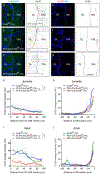Selective Cre-mediated gene deletion identifies connexin 43 as the main connexin channel supporting olfactory ensheathing cell networks
- PMID: 30628061
- PMCID: PMC6401266
- DOI: 10.1002/cne.24628
Selective Cre-mediated gene deletion identifies connexin 43 as the main connexin channel supporting olfactory ensheathing cell networks
Abstract
Many functions of glial cells depend on the formation of selective glial networks mediated by gap junctions formed by members of the connexin family. Olfactory ensheathing cells (OECs) are specialized glia associated with olfactory sensory neuron axons. Like other glia, they form selective networks, however, the connexins that support OEC connectivity in vivo have not been identified. We used an in vivo mouse model to selectively delete candidate connexin genes with temporal control from OECs and address the physiological consequences. Using this model, we effectively abolished the expression of connexin 43 (Cx43) in OECs in both juvenile and adult mice. Cx43-deleted OECs exhibited features consistent with the loss of gap junctions including reduced membrane conductance, largely reduced sensitivity to the gap junction blocker meclofenamic acid and loss of dye coupling. This indicates that Cx43, a typically astrocytic connexin, is the main connexin forming functional channels in OECs. Despite these changes in functional properties, the deletion of Cx43 deletion did not alter the density of OECs. The strategy used here may prove useful to delete other candidate genes to better understand the functional roles of OECs in vivo.
Keywords: Cre recombinase; RRID:AB_10000325; RRID:AB_141596; RRID:AB_2110187; RRID:AB_2533973; RRID:AB_2533979; RRID:AB_2576217; RRID:AB_561049; RRID:IMSR_JAX:005975; RRID:IMSR_JAX:007914; RRID:IMSR_JAX:008039; connexin 43; gap junctions; olfactory ensheathing cells; proteolipid protein.
© 2019 Wiley Periodicals, Inc.
Figures






Similar articles
-
Olfactory ensheathing cell membrane properties are shaped by connectivity.Glia. 2010 Apr 15;58(6):665-78. doi: 10.1002/glia.20953. Glia. 2010. PMID: 19998494 Free PMC article.
-
Olfactory ensheathing cells from the nasal mucosa and olfactory bulb have distinct membrane properties.J Neurosci Res. 2020 May;98(5):888-901. doi: 10.1002/jnr.24566. Epub 2019 Dec 4. J Neurosci Res. 2020. PMID: 31797433
-
Novel insights into the glia limitans of the olfactory nervous system.J Comp Neurol. 2019 May 1;527(7):1228-1244. doi: 10.1002/cne.24618. Epub 2019 Jan 16. J Comp Neurol. 2019. PMID: 30592044
-
The culture of olfactory ensheathing cells (OECs)--a distinct glial cell type.Exp Neurol. 2011 May;229(1):2-9. doi: 10.1016/j.expneurol.2010.08.020. Epub 2010 Sep 15. Exp Neurol. 2011. PMID: 20816825 Free PMC article. Review.
-
Consequences of impaired gap junctional communication in glial cells.Adv Exp Med Biol. 1999;468:373-81. doi: 10.1007/978-1-4615-4685-6_29. Adv Exp Med Biol. 1999. PMID: 10635043 Review.
Cited by
-
Insights into olfactory ensheathing cell development from a laser-microdissection and transcriptome-profiling approach.Glia. 2020 Dec;68(12):2550-2584. doi: 10.1002/glia.23870. Epub 2020 Aug 28. Glia. 2020. PMID: 32857879 Free PMC article.
-
Beneficial and Detrimental Remodeling of Glial Connexin and Pannexin Functions in Rodent Models of Nervous System Diseases.Front Cell Neurosci. 2019 Nov 6;13:491. doi: 10.3389/fncel.2019.00491. eCollection 2019. Front Cell Neurosci. 2019. PMID: 31780897 Free PMC article.
-
AMPA Receptor-Mediated Ca2+ Transients in Mouse Olfactory Ensheathing Cells.Front Cell Neurosci. 2019 Oct 4;13:451. doi: 10.3389/fncel.2019.00451. eCollection 2019. Front Cell Neurosci. 2019. PMID: 31636544 Free PMC article.
-
Multiomics Immune-Related lncRNA Analysis of Oral Squamous Cell Carcinoma and Its Correlation with Prognosis.Dis Markers. 2022 Sep 8;2022:6106503. doi: 10.1155/2022/6106503. eCollection 2022. Dis Markers. 2022. Retraction in: Dis Markers. 2023 Jun 21;2023:9861260. doi: 10.1155/2023/9861260. PMID: 36118668 Free PMC article. Retracted.
References
Publication types
MeSH terms
Substances
Grants and funding
LinkOut - more resources
Full Text Sources
Molecular Biology Databases
Miscellaneous

